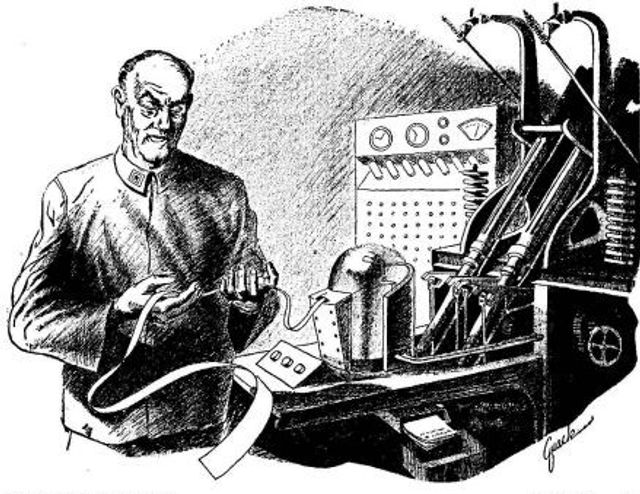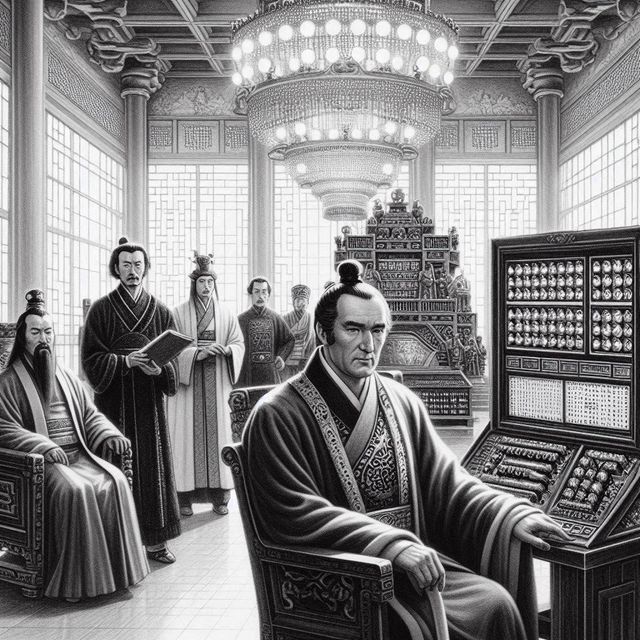-
Vijay Fafat
- Published on
This is a clever game-theoretic story about a man outwitting a formidable computing machine by doing almost nothing. Prince Kallin is the leader of the “League of Border States”, of which “the Dictator” wants to gain control. Both sides have formidable decision-analyzing machines (“Political Science Calculators”) deployed for political science analysis to guide the leaders, though the Dictator’s machine is far more advanced (“your machine’s reference file alone covers five square miles”).
Prince Kallin, also known as “Peynor”, is also one of the foremost mathematicians active in the field of “Symbolic Logic or the Mathematics of Social Science”, working on the problem of specifying the theoretical limitations on a machine’s decision-capabilities. This is well-known to all and sundry, including the Dictator’s machine, which is programmed to defend itself against all software attacks. To outwit this machine, Peynor devises a simple plan. He simply appears unannounced a week ahead of treaty negotiations on the Dictator’s planet and ensures that indirectly, the machine receives the input that Peynor, one of the greatest experts in machine intelligence, may be trying to disrupt it. This knowledge, by itself, sends the machine into a tailspin (“he knows that I know that he knows” kind). As Dr. Albert Fenrose, another expert mathematician, explains to the Dictator’s Minister of Foreign Affairs:
“Consider. The Machine employs logical tools. In its operations, it is very much like a brain, except that the brain can ignore or, at least, repress what it has to. The Machine cannot.
Peynor arrived. He carefully used that name to make sure the Machine did not miss the point that he was the outstanding expert on the limitations of the Machine. Just to reinforce it a bit, though it was probably not necessary, he told you that he chose his manner of coming to paralyze the Machine—which nugget of information you blithely cranked into it, thereby completing the process. After that he did precisely nothing.
[..]
There was nothing coherent the Machine could grasp. So the Machine went crazy.”
[…]
“The Machine knew that Peynor wanted to destroy it. And it knew that he could do this if anyone could. Further, by his exhibition of confidence, it became highly probable that he had a plan he knew would work. Now the Machine is quite capable of dealing with a plan to destroy or circumvent it. In fact, it is used to it. Under the present administration, that’s its main job. [..] The machine knew, with high probability, that Peynor had a plan. But he carefully avoided giving it any rational starting point. Therefore, to handle the problem, it had to consider the sum total of everything it could not do. It had to integrate over the range of its own limitations. And that is precisely what it could not do.”
[…]
“The basic difficulty, you see,” he continued, “is that the Machine, like the brain, cannot know the extent of its own limitations. […]At best, the brain can only know what it can do—not what it cannot do.”
[…]
“What Peynor, the mathematician, has done is to prove that, logically and in a more general form. The brain has a defense against that attack. It ignores it. If , however, we built an ignoring circuit into the machine, it would still be susceptible to a higher order form of attack since it must then decide if the problem must be ignored or not. And it always will be susceptible as long as it was devised by the human brain.”
[…]
“What Peynor, or Kallin, did, was to set before the Machine the one intolerable problem. He asked it to determine where it was vulnerable. And as long as he committed himself to no particular line of action, the problem remained.”
In the ensuing confusion, Prince Kallin obtains a treaty which contains the seeds of the destruction of the dictatorship at the hands of the common population.
As I read the story, I was reminded of game theory, Turing’s halting problem and Roger Penrose’s “The Emperor’s New Mind”, with his use of Godel’s Incompleteness Theorems to argue - as others had done before him - that the human brain could transcend the limitations of calculated logic with something more ineffable than the axiomatic method on which machines are based.

